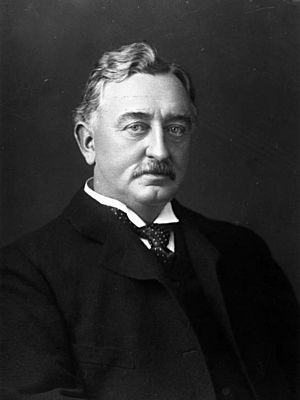Zambia Independence Act 1964 facts for kids

|
|
| Long title | An Act to make provision for, and in connection with, the establishment of Northern Rhodesia, under the name of Zambia, as an independent republic within the Commonwealth. |
|---|---|
| Citation | 1964 c. 65 |
| Introduced by | Andrew Cavendish, 11th Duke of Devonshire Under-Secretary of State for Commonwealth Relations |
| Dates | |
| Royal assent | 31 July 1964 |
|
Status: Current legislation
|
|
| Revised text of statute as amended | |
The Zambia Independence Act 1964 was a special law passed by the Parliament of the United Kingdom. This law gave Zambia its independence. Before 1964, Zambia was known as Northern Rhodesia and was controlled by Britain.
This Act made Northern Rhodesia a free country called Zambia. This happened on October 24, 1964. The law also allowed people in Zambia to still appeal to a high court in Britain if needed. Andrew Cavendish, 11th Duke of Devonshire, a British government official, helped introduce this important law.
Contents
How Zambia Became Independent
To understand how Zambia became independent, we need to look back at its history. For many years, the area was under British control.
Early British Influence
In 1888, a company called the British South Africa Company (BSA Company) became very powerful in the region. This company was led by Cecil Rhodes. They gained rights to dig for minerals from the Lozi people's chief. This area later became known as Barotziland-North-Western Rhodesia.
Around the same time, in the eastern part of the country, some Ngoni people rebelled. This rebellion was stopped, and the Ngoni leader accepted British rule. This eastern area became North-Eastern Rhodesia. In 1895, an American scout named Frederick Russell Burnham found large copper deposits in the region.
Forming Northern Rhodesia
For a while, North-Eastern Rhodesia and Barotziland-North-Western Rhodesia were managed separately. But in 1911, they were joined together. This new, larger area was named Northern Rhodesia. It became a British protectorate, meaning Britain protected and controlled it.
In 1923, the BSA Company gave up its control of Northern Rhodesia. The British government then took over.
British Control and Changes
In 1923, Southern Rhodesia (which is now Zimbabwe) also changed. It had been managed by the BSA Company too. But it became a self-governing British colony. This meant it had more control over its own affairs.
In 1924, after some talks, the British government's Colonial Office took charge of Northern Rhodesia.
The Federation of Rhodesia and Nyasaland
In 1953, a new group was formed called the Federation of Rhodesia and Nyasaland. This group brought together Northern Rhodesia, Southern Rhodesia, and Nyasaland (now Malawi). They became one large, partly self-governing region.
Many people in these areas did not like this idea. They protested against it, especially in 1960 and 1961. Northern Rhodesia was a main place where these protests and problems happened. At first, Harry Nkumbula's African National Congress (ANC) led the fight against the Federation. Later, Kenneth Kaunda's United National Independence Party (UNIP) took over.
Becoming an Independent Nation
In 1962, elections were held in Northern Rhodesia. These elections led to a council where African leaders had the most power. The two main African nationalist parties formed a partnership.
This new council decided that Northern Rhodesia should leave the Federation. They also demanded that the country should govern itself completely. They wanted a new constitution and a new National Assembly with more people able to vote.
The Federation Ends
The Federation of Rhodesia and Nyasaland officially ended on December 31, 1963. In January 1964, Kenneth Kaunda won the election to become the first Prime Minister of Northern Rhodesia.
The British Governor of Northern Rhodesia, Sir Evelyn Dennison Hone, was very supportive of Kaunda. He encouraged Kaunda to become prime minister. Soon after, there was a small uprising in the north of the country called the Lumpa Uprising. This was Kaunda's first big challenge as a leader.
Zambia is Born
Northern Rhodesia officially became the Republic of Zambia on October 24, 1964. Kenneth Kaunda became the first president.
Even though Zambia had a lot of valuable minerals, it faced many challenges at independence. There were not many trained Zambians ready to run the government. The economy also relied a lot on experts from other countries. Many Europeans lived in Zambia in 1964, and they played a big role in the economy.




